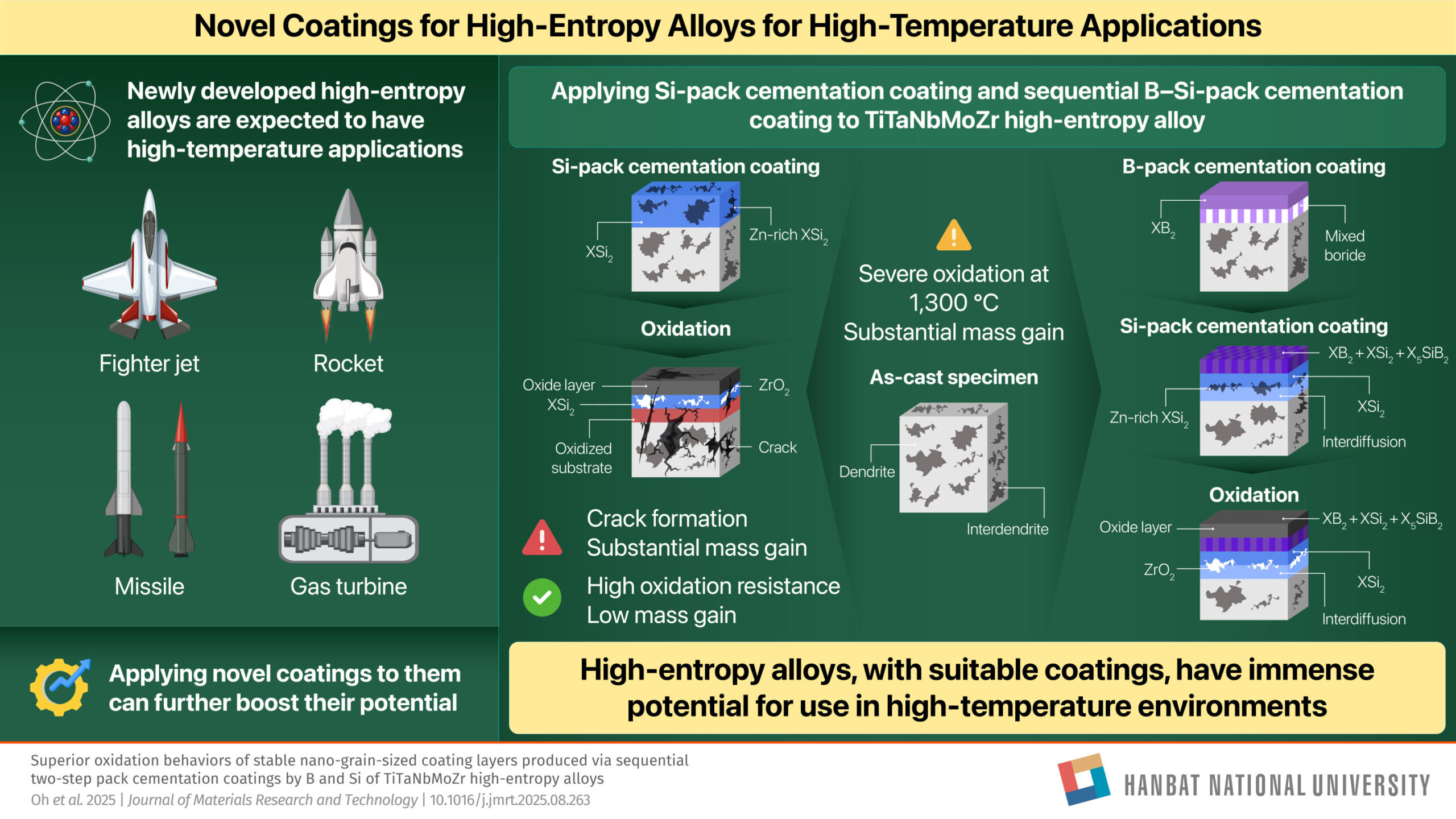
The aerospace industry has undergone tremendous developments over the last century, with materials science engineers playing a significant role in this transformation. It is well known that as the operating temperature of metallic materials increases, the speed of aircraft can be enhanced and fuel consumption can be reduced.
Therefore, research on high-temperature materials has been directly linked to the improvement of aircraft performance and has been actively conducted worldwide since the 1940s.
For more than 80 years, Ni-based alloys have been the primary materials used for high-temperature applications. To enable their use at even higher temperatures, ceramic coatings have been applied to the Ni alloys. However, due to the intrinsic softening of Ni-based alloys, their operating temperature cannot exceed approximately 1,100 °C.
In recent years, high-entropy alloys—a concoction of various metallic and other elements with desirable properties—have emerged as a highly promising alternative for use in such extreme scenarios. Notably, applying novel coatings to the newly developed high-entropy alloys is expected to allow these materials to be used at significantly higher temperatures.
In a new development, a team of researchers from the Republic of Korea, led by Joonsik Park, a Professor of Materials Science and Engineering at Hanbat National University, has demonstrated the superior oxidation behaviors of stable nano-grain-sized coating layers produced via sequential two-step B and Si pack cementation coatings of TiTaNbMoZr high-entropy alloys.
Their novel findings were published in the Journal of Materials Research and Technology.
In the study, the researchers compared the application of Si-pack cementation coating and sequential B–Si-pack cementation coating to the TiTaNbMoZr alloy. They found that not only did the as-cast untreated alloy experience extreme oxidation at 1,300 °C, but the Si-pack cementation-coated high-entropy alloy also showed crack formation due to the oxidation of Zr-rich XSi2 to ZrO2, comprising coating integrity.
Interestingly, the B–Si-pack cementation-coated TiTaNbMoZr alloy developed a structurally stable surface layer comprising XB2, XSi2, and X5SiB2, demonstrating superior oxidation resistance even at very high temperatures.
Moreover, while the as-cast alloy and the Si-pack cementation-coated alloy demonstrated high mass gains after oxidation at 1,300 °C for 10 hours, their B–Si-pack cementation-coated counterpart exhibited significantly lower mass gain under the same conditions. Furthermore, the parabolic rate constant was found to be quite small after the protective oxide layer formation.
The key point of this study is that even after being exposed to a remarkably high temperature of 1,300 °C, the coating layer of the recently developed high-entropy alloys maintains its nanostructure while effectively protecting the substrate. This is the first study to demonstrate such a behavior.
“Currently, the Ni-based alloys used in missiles can operate at around 1,100 °C, but the results of our study show that the newly developed material can withstand temperatures far exceeding that limit,” highlights Prof. Park.
This material can be applied to components exposed to high-temperature flames, such as those in fighter jets and missiles. Utilizing the coating on various high-temperature structural materials, it offers broad applicability for defense purposes as well as other high-temperature engineering fields.
“Overall, our results confirm the potential of high-entropy alloys for use in high-temperature environments and emphasize the critical role of selecting suitable coating strategies tailored to the alloy composition,” concludes Prof. Park.
More information:
J.S. Oh et al, Superior oxidation behaviors of stable nano-grain-sized coating layers produced via sequential two-step pack cementation coatings by B and Si of TiTaNbMoZr high-entropy alloys, Journal of Materials Research and Technology (2025). DOI: 10.1016/j.jmrt.2025.08.263
Provided by
Hanbat National University Industry–University Cooperation Foundation
Citation:
Sequential coating technology could transform high-temperature alloy performance for aviation (2025, October 28)
retrieved 28 October 2025
from https://techxplore.com/news/2025-10-sequential-coating-technology-high-temperature.html
This document is subject to copyright. Apart from any fair dealing for the purpose of private study or research, no
part may be reproduced without the written permission. The content is provided for information purposes only.










